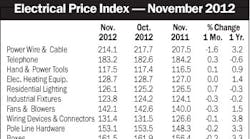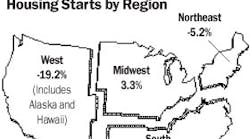Latest from Mag
People - Dec 21, 2012
Obituaries - Dec 21, 2012
November EPI Index Shows No Change
Housing Starts Dip 4% in November
Electrical Marketing - December 21, 2012
Around the Industry - Dec 21, 2012
While it’s not recession-proof, Minneapolis/St. Paul’s economy never hits unsustainable highs or dramatic lows as other regions of the United States do. Food processing and medical high-tech business tend to insulate the Minneapolis/St. Paul market from the ups and downs in the U.S. economy.
“Other markets seem to have steeper ups and downs than Minnesota,” said Kevin Powell, president of Werner Electric Supply of Minnesota, Minneapolis. “If you consider the diversity of business in Minneapolis, Minnesota’s biggest market, you gain an understanding of why.”
Added Greg Hames, president, Viking Electric Supply/Sonepar USA, Minneapolis, “We have a very stable overall economy that rarely sees large gains or decreases in the level of business activity.”
The Twin Cities of Minneapolis/St. Paul make up the 14th largest market in the United States, according to Hames.
Food processing companies are major employers in the area and Gary Brusacoram of Andrews-Johnson-Brusacoram, a manufacturers’ rep in Minneapolis, said Minnesota has 10 companies among the top 100 food processors in the United States. “This is a very substantial part of our Upper Midwest economy, about 22 percent of our manufacturing shipments,” he said. “This list would include General Mills, Land O’Lakes, Cargill, Hormell (Jennie O & Spam), Michael Food, American Crystal Sugar, Malt-O-Meal, Schwan’s and another 10 to 15 companies that have expanded their operations in the past few years.”
Hames of Viking/Sonepar USA said food processing also drives a robust OEM packaging industry in the area and that med-tech businesses such as Medtronic, St. Jude Medical and Boston Scientific are expanding their Twin Cities-based operations and office facilities. Other companies expanding operations include UnitedHealth Group, which is building a new hospital and new administration building; Cargill, which has a new office campus in Excelsior Crossings, Minn.; Dakota County’s huge new administration campus; IBM’s expansion in Rochester, Minn.; Mayo Clinic’s Gonda building expansion; Medtronic’s new campus completion; and the Region Hospital expansion.
3M is a big employer in the Minneapolis area, but most of 3M’s expansion has been outside of Minnesota. “3M has only built one new plant in the last 25 years and it was built in the Carolinas,” said Ken Rowland, Border States’ Northeast region manager in Coon Rapids, Minn. “They continue to invest in capital equipment and building expansion to support the production of new product.”
Ethanol is also driving the Minnesota economy. Ethanol is big in the Midwest because of the amount of available raw material, specifically corn, said Rowland. Fagan Inc., Granite Falls, Minn., a design-builder, has built approximately 50 percent of all the ethanol plants in the United States. The company is very busy and has projects extending beyond 2010, he said.
But at least one industry observer questions ethanol’s future. Werner Electric’s Powell said it’s difficult to tell if ethanol is a sustainable market. “Those with a disagreement with government subsidies will cite statistics on energy and water requirements to produce the end product,” he said. “Those with a stake in ethanol growth say most of the information in the media is old and outdated science or not factual, and that ethanol is a viable energy alternative with current technology.”
While the medical and food processing segments of the Minneapolis economy are enjoying steady growth, the area’s housing market has not escaped the impact of the national housing crisis. Minneapolis has seen year-to-date total building permits drop by 34 percent through September.
“The housing market is very depressed, and from what we are hearing and seeing around here, nobody is looking for a recovery before the fourth quarter of 2009,” said Border States’ Rowland. “They have basically stopped building new homes, which is increasing the inventory of existing homes for sale in the marketplace.”
Outside of the housing market, some exciting new construction projects are underway. Minneapolis recently broke ground on the new Twins baseball stadium, which is scheduled to open in 2010. The other big stadium project in Minneapolis right now is the construction of the University of Minnesota’s Gophers stadium. It’s scheduled to be completed in January 2008. “I am excited to see the construction get underway because commercial work will inevitably follow,” said Powell of Werner Electric.
Border States’ Rowland said his company in now negotiating for business for the Twins stadium, including the contracts for lighting and switchgear. Gephart Electric, St. Paul, a large electrical contractor in the area, was awarded the contract for the stadium.
Rowland said a big light-rail system — the North Star Transit — is being built in the same area as the Twins stadium. The light-rail system will extend about 50 miles outside of Minneapolis to Big Lakes, Minn.
Another major construction project in Minneapolis is the rebuilding of the Interstate 35W bridge, which is just starting and will run through 2008. On Aug. 1, the bridge, the main transportation artery in the heart of Minneapolis, fell into the Mississippi River killing 13 people and injuring more than 100 others.
“The I-35W bridge collapse had a negative impact on the Twin Cities market for a long time, but it seems the traffic flows have now adjusted to the disruption of a major artery into downtown Minneapolis,” said Hames of Viking Electric Supply. “The contract has been awarded for the construction of the new bridge and that completion will help the Minneapolis business market keep growing.”
Additionally, a number of projects in the Twin Cities are on hold awaiting approval of a Tax Increment Financing bill that Minnesota Governor Tim Pawlenty vetoed, said Lawless of LESCO. “When the legislature meets in January, we expect them to address this Tax Incremental Financing and if it’s approved, some large projects will quickly go back on track.”
These projects include the Mall of America expansion. While still in the planning stages, the Phase II mixed-used complex is zoned for up to 5.6 million square feet of new development and would be built on 42 acres of adjacent property to the north of Mall of America on the old site of the Met Center.
Herm Isenstein, president, DISC Corp., Orange, Conn., forecasts that electrical distributors in the Minneapolis/St. Paul metropolitan area sold approximately $1 billion in electrical products in 2007. No growth in total sales is expected in 2008.
Renewable energy is the bright star on the horizon, according to Border States’ Rowland. “There is one major market segment that shows significant opportunity for the future and that is in renewable energy, which would be some type of biofuel or wind generation,” he says. “That will also spur some additional growth in electric transmission. They must build new transmission lines to get the electricity to the grid, and there are a significant amount of wind generation projects in the Upper Midwest.”

